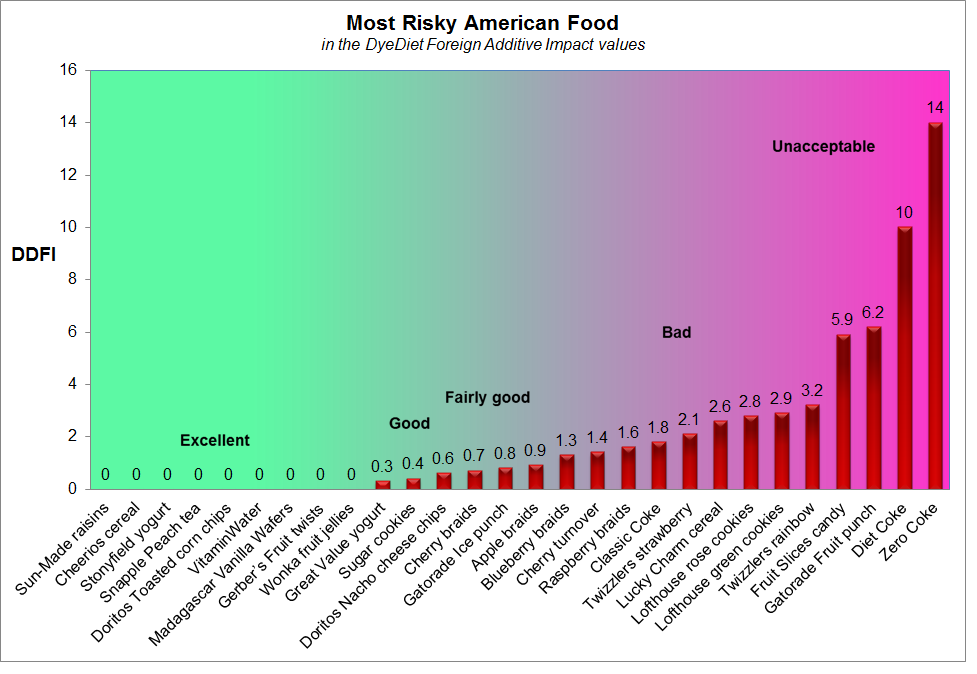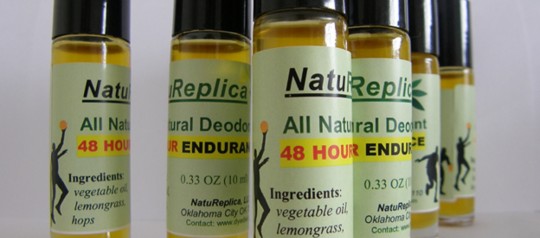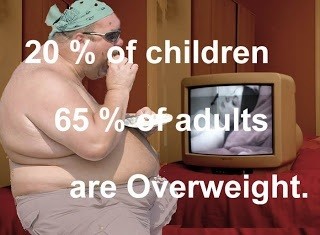Most Risky Food in America
DyeDiet Food Risk Overview
It has been two months since the DyeDiet started publication of its concept and analysis of health risks associated with consumption of food and food additives. So far 28 popular brands of food and soft drinks from 8 food categories were discussed in terms of food risks so to help American consumers to make more informed, less risky food choices. Today we present the first cumulative comparison of the previously reviewed foods and beverages in the scale of the DyeDiet Foreign Additive Risk Impact (DDFI) explained earlier.
- As you can see from the above chart, the healthy green zone is occupied with the foods containing ZERO foreign additives and, hence, they are most nutritional ones with DDFI = 0.
- Starting from Great Value yogurt foreign chemical additives increasingly contribute to the overall health risk and the DDFI. As to which is “good’ and which is “bad,” I would say “good” is DDFI < 0.5 and “fairly good,” is within 0.5 – 0.8 DyeDiet recommended up to Gatorade ice punch as low risk foods. Everything exceeding DDFI > 1.0 is pretty “bad” falling into “junk food” category. So the DyeDiet does not recommend consumption of such “bad” risky foods.
- The health risk champions are Zero Coke, Diet Coke, and Gatorade fruit punch followed by sugar candy, Twizzlers and Lofthouse cookies. The higher DDFI value the more risky and less nutritious is food. Accordingly, these products are rated as “unacceptable” for regular consumption.
Please remember that the DyeDiet food risk rating is based solely on the analysis of the following information:
- The ingredients list on the labels;
- A chemical structure, to determine foreign or nutritional nature of an additive;
- The available data on possible adverse health effects of a food additive
I hope this report has illustrated the applicability of the DDFI approach to comparison of foods from different categories. As it was explained earlier, the DyeDier Risk Score values (DDRS) may also be useful within the same food category. Indeed, DDRS and DDFI of closely related food products correlate, as you can see for the Wal-Mart baked goods comparison below.
Vote the foreign food additives out!
Now, if you agree with the DyeDiet Food Risk Assessment approach, it is your turn to to vote out risky foods with your dollar by making healthier food choices for you and your children. Looks like, this is the right time to do so. Sadly, FDA just demonstrated to the US public that we are on our own: “There is no proof that foods with artificial colorings cause hyperactivity in most children and there is no need for these foods to carry special warning labels”. Well, even if so, is there enough proof that the food dyes do not cause hyperactivity and other health conditions in children and adults? You know the answer: “No”! Then why we keep running this nationwide toxicology test on the US population and who benefit out of it?
The DyeDiet standpoint is not to prove or disprove toxicity of the food dyes or any other biologically foreign food additives. The DyeDiet goal is to eliminate them all for a very clear fundamental reason: based on their chemical structures they simply have no use in the human molecular biology! With your active help we can stop the “dye diet” test and make the future of our children healthier. So what is YOUR choice?
Category: Food and Risk









You made some first rate factors there. I looked on the internet for the difficulty and located most people will associate with with your website.